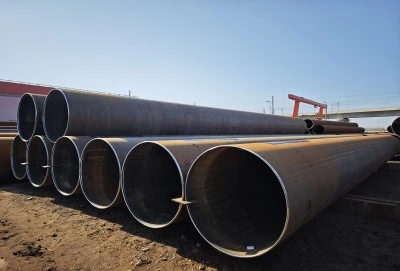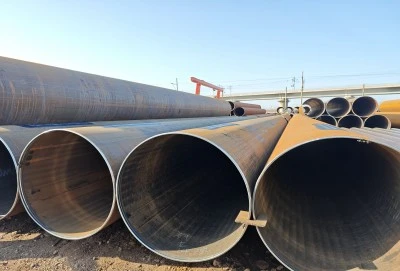Double seam welded pipes have become an integral component in various marine applications, offering exceptional strength and durability in harsh oceanic environments. These pipes, manufactured through a sophisticated welding process, are designed to withstand the corrosive nature of seawater and the extreme pressures found in deep-sea conditions. In this comprehensive guide, we'll explore the diverse marine applications, their suitability for marine environments, their corrosion resistance properties, and the types of vessels and offshore structures that rely on them.
|
|
|
Why is Double Seam Welding Ideal for Marine Environments?
Double seam welded pipes are particularly well-suited for marine applications due to their unique manufacturing process and resulting properties. The double seam welding technique involves welding both the inside and outside of the pipe, creating a strong, uniform seam that can withstand high pressures and resist corrosion. This method produces pipes with superior structural integrity compared to single-seam welded pipes, making them ideal for the challenging conditions encountered in marine environments.
The marine environment presents several challenges for piping systems, including:
- Constant exposure to saltwater
- High humidity levels
- Extreme temperature fluctuations
- High-pressure conditions (especially in deep-sea applications)
- Potential impact from marine life and debris
Double seam welded pipes address these challenges effectively. The double welding process creates a more robust seal, reducing the risk of leaks and structural failures. Additionally, the pipes can be manufactured using corrosion-resistant materials such as stainless steel or specialized alloys, further enhancing their durability in marine settings.
The superior strength of double seam welded pipes also allows for thinner wall thicknesses compared to other pipe types, resulting in weight savings without compromising performance. This is particularly advantageous in marine applications where weight considerations are crucial, such as in offshore platforms and ship construction.
How Do Double Seam Welded Pipes Withstand Seawater Corrosion?
Corrosion resistance is a critical factor in marine applications, and double seam welded pipes excel in this aspect. The pipes' ability to withstand seawater corrosion is attributed to several factors:
1. Material Selection: Double seam welded pipes used in marine environments are typically manufactured from corrosion-resistant materials. Stainless steel grades such as 316L and duplex stainless steels are commonly used due to their excellent resistance to chloride-induced corrosion. These materials form a protective oxide layer on their surface, which acts as a barrier against corrosive elements in seawater.
2. Welding Process: The double seam welding process itself contributes to corrosion resistance. By welding both the inside and outside of the pipe, the technique minimizes areas of potential weakness where corrosion could initiate. The uniform weld seam also reduces the likelihood of crevice corrosion, which can occur in gaps or joints.
3. Surface Treatments: After welding, pipes may undergo additional surface treatments to enhance their corrosion resistance. These treatments can include:
- Passivation: A chemical process that removes free iron from the surface and enhances the formation of the protective oxide layer.
- Electropolishing: An electrochemical technique that smooths the surface, reducing potential sites for corrosion initiation.
- Protective Coatings: Application of specialized marine-grade coatings that provide an additional barrier against corrosive elements.
4. Cathodic Protection: In many marine applications, double seam welded pipes are used in conjunction with cathodic protection systems. These systems use sacrificial anodes or impressed current to prevent corrosion by making the pipe structure cathodic (negatively charged) relative to its environment.
The combination of these factors allows double seam pipes to maintain their integrity and performance even after prolonged exposure to seawater. This longevity makes them a cost-effective choice for marine applications, reducing the need for frequent replacements and minimizing maintenance requirements.
What Types of Ships and Offshore Structures Use Double Seam Welded Pipes?
Double seam welded pipes find extensive use in a wide range of marine vessels and offshore structures. Their versatility and durability make them suitable for various applications across the maritime industry. Some of the key areas where these pipes are utilized include:
1. Oil Tankers and LNG Carriers: Double seam welded pipes are crucial components in the construction of large vessels designed to transport oil and liquefied natural gas. They are used in:
- Cargo piping systems for loading and unloading
- Ballast water systems
- Fuel transfer lines
- Inert gas systems for tank protection
The pipes' ability to withstand high pressures and resist corrosion makes them ideal for handling these volatile substances in marine environments.
2. Offshore Oil and Gas Platforms: In the offshore energy sector, double seam welded pipes play a vital role in:
- Production risers for transporting oil and gas from the seabed to the platform
- Water injection systems for enhanced oil recovery
- Cooling water systems
- Fire protection systems
The pipes' durability and resistance to both internal and external corrosion are crucial in these applications, where reliability and safety are paramount.
3. Subsea Pipelines: Double seam welded pipes are extensively used in the construction of subsea pipelines for:
- Oil and gas transportation
- Water injection
- Chemical injection lines
These pipes are designed to withstand extreme pressures at great depths and resist corrosion from both seawater and the transported fluids.
4. Cruise Ships and Passenger Vessels: In large passenger vessels, double seam pipes are used for:
- Freshwater and wastewater systems
- HVAC piping
- Ballast systems
- Firefighting systems
The pipes' corrosion resistance and durability ensure the reliability of these critical systems throughout the vessel's lifecycle.
5. Naval Vessels: Military ships employ double seam pipes in various systems, including:
- Fuel lines
- Hydraulic systems
- Seawater cooling systems
- Damage control piping
The pipes' robust construction and resistance to shock and vibration make them suitable for the demanding requirements of naval applications.
6. Offshore Wind Farms: As the renewable energy sector expands into offshore environments, double seam welded pipes are being used in:
- Foundation structures for wind turbines
- Power transmission cables protection
- Cooling systems for offshore substations
The pipes' ability to withstand harsh marine conditions and resist corrosion contributes to the longevity and reliability of these renewable energy installations.
Contact Longma
Double seam pipes have proven to be indispensable in a wide array of marine applications, from massive oil tankers to cutting-edge offshore wind farms. Their exceptional corrosion resistance, strength, and durability make them an ideal choice for the challenging conditions encountered in marine environments. As the maritime industry continues to evolve, with increasing demands for efficiency, safety, and environmental protection, its role is likely to grow even further.
If you're involved in marine engineering, shipbuilding, or offshore construction, considering double seam pipes for your projects could significantly enhance the longevity and performance of your structures. To learn more about how our high-quality double seam welded pipes can benefit your marine applications, don't hesitate to reach out to our team of experts. Contact us at info@longma-group.com for personalized advice and solutions tailored to your specific needs. Let's work together to build stronger, more durable marine structures that can withstand the test of time and tide.














